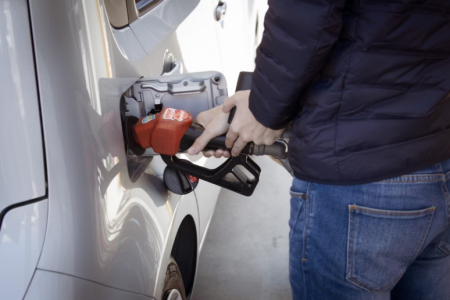She saved $30 with this odd fueling trick—and now others are trying it too
- Replies 0
If you’ve ever stood at the gas pump, watching the numbers rise like a stock ticker, you’ve probably wondered if there’s a better way.
One online user claims there is—and she’s got the footage to prove it. Her trick involves pumping gas more slowly, and she says it nearly doubled her car’s driving range on just $30 of fuel.
Could it really be that simple, or is this just another viral myth ready to be debunked?
Alecia, an online user posting under @aleciaa2, shared a viral video that has now reached over 1.3 million views, claiming a “slow-pour” fueling method changed her gas mileage dramatically.
“God bless the person that said when you’re getting, or like when you’re pumping your gas, to put it on the slow setting,” she said in her June 23 video.
Her phone then cuts to her dashboard, clearly showing a driving range of 522 miles after spending just $30 on fuel.
“It usually takes me $60 to fill my tank to like 400 miles,” she explained, sounding genuinely surprised.

The internet immediately lit up with reactions—some supportive, some skeptical, and some demanding a scientific explanation.
“Mine added an extra 100 miles when I did it!!” wrote one enthusiastic commenter. Another user chimed in, “Worked for me this week. Usually takes 65-70 to even get to near full. I did it with 50.”
Others echoed that it took longer to fill but seemed worth it, with one user saying, “I just did this yesterday lol it takes longer to fill, but it’s worth it.”
Still, not everyone was convinced by the video or the logic behind it, and experts were quick to voice their doubts. “I work for a fuel company. Trust me. It doesn’t work like that but if it makes you feel better sure!” one commenter posted.
Read also: You might be overpaying for internet—here’s how to fix it fast
Another skeptical viewer added, “That has never worked for me I’ve tire this. This past weekend and got the same amount of gas.”
A third person wrote, “Gas pumps measure fuel by volume using a flow meter. Air or foam does not add any volume. Can someone explain?”
While the video has ignited debate, the science of gas pumps leaves little room for this trick to be real.
According to the AAA and other fuel industry experts, gas pumps use flow meters to measure the exact amount of fuel being dispensed, regardless of how quickly or slowly you pump.
Source: aleciaa2 / TikTok
Alecia’s theory about avoiding air bubbles and vapor loss simply doesn’t align with how modern pumps function.
Experts further explained that vapor loss occurs later, when fuel sits in a hot tank, not during a slow fill-up.
Some commenters floated other suggestions that also lack strong scientific backing, such as filling up at night when fuel is supposedly denser.
While it's true that gasoline expands slightly in heat, the tanks at gas stations are buried underground, where the temperature is stable.
Read also: Don’t miss out: How you could get $175 checks and cut at least $60 off your sky-high summer energy bills
Any increase in efficiency from cooler fuel would be negligible and unlikely to account for the dramatic difference Alecia showed.
One user claimed, “also go at night or early morning when the ground is cooler!!” But again, the impact of timing is very minor.
What might explain the wildly different range displays after fill-ups is your vehicle's onboard computer system and recent driving behavior.
Dashboard mileage estimates are dynamic and change depending on your average fuel consumption over recent trips, not just based on how much fuel is added.
So if you’ve been driving more efficiently than usual, the system could easily project a higher range after a refill, regardless of pumping speed. It’s a common misunderstanding, especially when you don’t account for changes in driving patterns.
Read next: Gas prices surge nationwide as new tensions spark supply fears

Have you tried the slow-pour gas trick, or do you have a better tip for stretching your fuel dollars? We want to hear from real drivers with real results, whether you’ve gained mileage or spotted a skimmer. Share your experiences in the comments and help separate the fact from fiction for everyone else at the pump. Let’s build a smarter, safer, and more fuel-efficient community—one tank at a time.
One online user claims there is—and she’s got the footage to prove it. Her trick involves pumping gas more slowly, and she says it nearly doubled her car’s driving range on just $30 of fuel.
Could it really be that simple, or is this just another viral myth ready to be debunked?
Alecia, an online user posting under @aleciaa2, shared a viral video that has now reached over 1.3 million views, claiming a “slow-pour” fueling method changed her gas mileage dramatically.
“God bless the person that said when you’re getting, or like when you’re pumping your gas, to put it on the slow setting,” she said in her June 23 video.
Her phone then cuts to her dashboard, clearly showing a driving range of 522 miles after spending just $30 on fuel.
“It usually takes me $60 to fill my tank to like 400 miles,” she explained, sounding genuinely surprised.

She saved $30 with this odd fueling trick—and now others are trying it too. Image source: sippakorn yamkasikorn / Unsplash
The internet immediately lit up with reactions—some supportive, some skeptical, and some demanding a scientific explanation.
“Mine added an extra 100 miles when I did it!!” wrote one enthusiastic commenter. Another user chimed in, “Worked for me this week. Usually takes 65-70 to even get to near full. I did it with 50.”
Others echoed that it took longer to fill but seemed worth it, with one user saying, “I just did this yesterday lol it takes longer to fill, but it’s worth it.”
Still, not everyone was convinced by the video or the logic behind it, and experts were quick to voice their doubts. “I work for a fuel company. Trust me. It doesn’t work like that but if it makes you feel better sure!” one commenter posted.
Read also: You might be overpaying for internet—here’s how to fix it fast
Another skeptical viewer added, “That has never worked for me I’ve tire this. This past weekend and got the same amount of gas.”
A third person wrote, “Gas pumps measure fuel by volume using a flow meter. Air or foam does not add any volume. Can someone explain?”
While the video has ignited debate, the science of gas pumps leaves little room for this trick to be real.
According to the AAA and other fuel industry experts, gas pumps use flow meters to measure the exact amount of fuel being dispensed, regardless of how quickly or slowly you pump.
Source: aleciaa2 / TikTok
Alecia’s theory about avoiding air bubbles and vapor loss simply doesn’t align with how modern pumps function.
Experts further explained that vapor loss occurs later, when fuel sits in a hot tank, not during a slow fill-up.
Some commenters floated other suggestions that also lack strong scientific backing, such as filling up at night when fuel is supposedly denser.
While it's true that gasoline expands slightly in heat, the tanks at gas stations are buried underground, where the temperature is stable.
Read also: Don’t miss out: How you could get $175 checks and cut at least $60 off your sky-high summer energy bills
Any increase in efficiency from cooler fuel would be negligible and unlikely to account for the dramatic difference Alecia showed.
One user claimed, “also go at night or early morning when the ground is cooler!!” But again, the impact of timing is very minor.
What might explain the wildly different range displays after fill-ups is your vehicle's onboard computer system and recent driving behavior.
Dashboard mileage estimates are dynamic and change depending on your average fuel consumption over recent trips, not just based on how much fuel is added.
So if you’ve been driving more efficiently than usual, the system could easily project a higher range after a refill, regardless of pumping speed. It’s a common misunderstanding, especially when you don’t account for changes in driving patterns.
Read next: Gas prices surge nationwide as new tensions spark supply fears
Key Takeaways
- An online post claim that slowly pumping petrol at the servo boosts your car’s driving range and saves you cash, sparking a heated debate online.
- Some drivers in the comments reckoned the slow-pour fuel trick worked for them, while plenty of others—including industry experts and the AAA—dismissed it as a myth.
- Experts and fuel companies pointed out that modern petrol pumps measure by volume, not speed, and that your pumping pace won’t change how much petrol you actually get.
- A separate online trick was mentioned, warning drivers to check for card skimmers at the browser—a real way to avoid getting ripped off at the servo.
Last edited:






